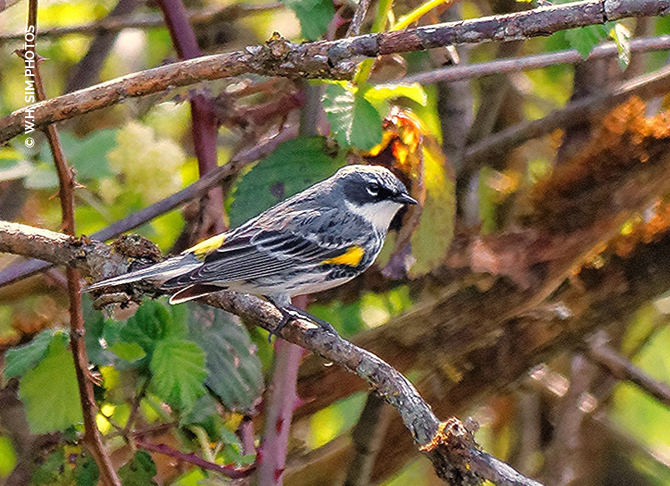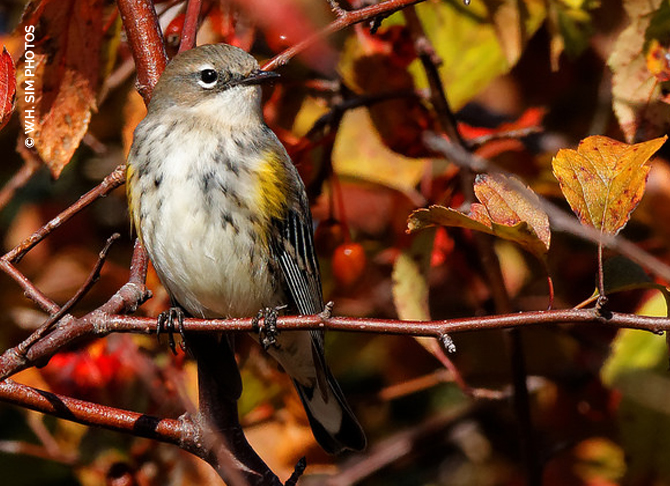This gallery contains 3 photos. It hardly seems fair–or flattering–to be described by the colour of your bottom, especially when you are those pretty songbirds known as Yellow-Rumped Warblers. Active balls of energy who constantly hop and/or fly from bush to tree, YRWAs may show off their visually most dazzling wardrobes in the spring, with dashing hues of black, white, grey and bright yellow, but autumn is when they gather in huge droves to feast on fall berries, just as insects are starting to become scarce.

distant shot of an adult male YRWA (Myrtle variant) at Colony Farm on April 18, 2015
f/8, 1/500, 500mm, ISO 1250
I have yet to photograph these beautiful songbirds at close range in their breeding plumage, as these insect-and-fruit eaters tend to be high up in the trees in the spring and summer, and they are rarely still for moment than a few seconds. I did get a glimpse of a handsome male this summer–and he had the unfortunate distinction of being adoptive father to (at least) one juvenile Brown-Headed Cowbird. But by the time I had my camera raised, said dad–who was a tantalizing 6-7 feet away from me–had flown off to a far less accessible perch in one of the 100-foot Douglas Firs in the backyard.

a juvenile/female YRWA poses for a photo at the Boundary Bay Wildlife Area on September 15, 2016
f/6.3, 1/400, 500mm, ISO 400
Once in a while, though, a few of these extremely sociable warblers (usually juveniles or females) may decide to be a little more co-operative and pause long enough for me to photograph them. “Butterbutts”, as they are sometimes affectionately known to birders, are among the best known of songbirds in the Northern Hemisphere. They also stick around much longer [in the fall] than other neotropical migrants will, so chances are good that if you hearing lots of singing and see plenty of wings fluttering in a tree, you’re witnessing a flock of Yellow-Rumped Warblers feeding and foraging.

an adult male YRWA in fall attire at Boundary Bay Wildlife Area on October 5, 2016
f/14, 1/640, 500mm, ISO 800
The variant of Yellow-Rumped Warblers that tends to be seen most often in Metro Vancouver and Western Canada is the Audubon variety, which has, as one of its more recognizable field marks, an additional yellow patch on its throat (interestingly, though, it was the Myrtle variant who figured into my latest photos). On a related note: after more than 40 years of being lumped together as Yellow-Rumped Warblers, three variants–Myrtle, Audubon, and Goldman’s–may soon be split back into their separate species, thanks to recent discoveries that suggest that their DNAs have diverged significantly over the last million years1 to the point that they are indeed different warbler species.2 It is staggering to think that of the 10,000 species of birds in existence today, many have been around for much much longer than we have walked the earth. To learn more about the Yellow-Rumped Warbler, visit its Cornell Lab of Ornithology allaboutbirds.org profile here.
SOURCES
1 Butterbutt Warbler Likely Three Different Species, DNA Reveals (Cornell University, Hugh Powell, August 24, 2016).
2 The Yellow-Rumped Warbler Will Probably Be Split Into Different Species Again (Audubon, Kenn Kaufman, September 1, 2016).
MY ZAZZLE WEBSITE www.zazzle.com/walkswithnature
ON FACEBOOK www.facebook.com/whsimphotography
ON TWITTER www.twitter.com/whuisim
ON GOOGLE+ plus.google.com/u/0/+WHSIM

Thanks for the information and the beautiful photographs.
LikeLiked by 2 people
you’re welcome, Susan!
LikeLike
Beautiful, thanks ! 🙂
All the best !
LikeLiked by 1 person
great picture 🙂
LikeLiked by 1 person
pictures*
LikeLiked by 1 person
Interesting post and terrific photos.
LikeLiked by 1 person
thank you, Belinda!
LikeLiked by 1 person
It is a beautiful bird.
Very beautiful pictures.
I wish you a nice weekend
LikeLiked by 1 person
thank you, Hervé!
LikeLiked by 1 person
These pictures are exquisite! So clear. I know they are not easy to capture, those flitty, flighty little creatures.
LikeLiked by 1 person
thank you, Mary! I can’t blame them — they are on a mission to feed! 🙂
LikeLiked by 1 person
These little exquisite birds are made special by the little pops of yellow.Great work!
LikeLiked by 1 person
thank you, Noelle!
LikeLike
Beautiful photos. Doncha just love the word ‘rump’! 😀
LikeLiked by 1 person
certainly makes this songbird seem so playful! 🙂
LikeLiked by 1 person